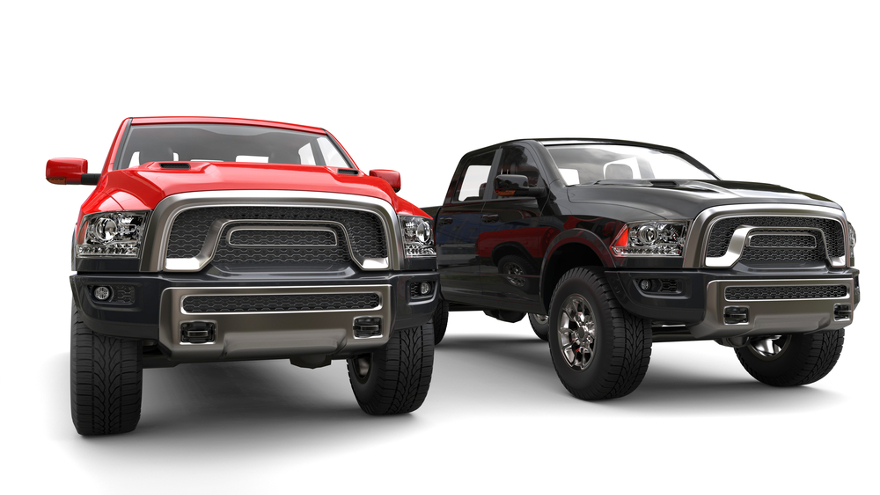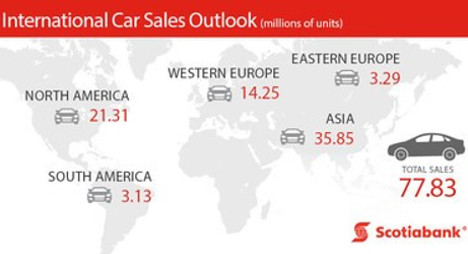Canadian auto sales have enjoyed record sales the past few years — but it looks like those numbers may have topped out in 2017.
That’s according to recent Canadian Black Book poll research that shows 51 percent of Canadian automotive consumers are expected to purchase a vehicle over the next two years. But apparently the numbers show that those surveyed last year were 11 percent more likely to buy soon.
That aside, one of the most interesting results from the recent poll that highlights automotive consumer trends is the apparent willingness of those in the market for a car to buy that vehicle online.
This is the third year in a row CBB has designed a poll, conducted by Ipsos, to gauge Canadian car buying habits, knowledge and trends. This year’s edition surveyed 1,255 Canadians from coast to coast.
The poll results showed that over a quarter (27 percent, to be exact) of Canadians are likely to purchase a vehicle fully on the web.
What are the demographics of the majority of that group willing to purchase a vehicle without stepping into the dealership?
According to the CBB poll:
- Thirty-six percent of those aged 18-34 would consider buying fully online, while only 11 percent of those over 55 would do so.
- And males are much more likely at 32 percent versus females at 21 percent.
“We are not surprised to see that millennials are over three times more likely to purchase a vehicle online compared to boomers,” says Brian Murphy, vice president of research and editorial at Canadian Black Book. “This would be a major shift in automotive retailing, and one that is similar to how millennials research, shop for and purchase so many of their goods today.”
As for what was the first tool that consumers turn to when researching a vehicle — that's dealer websites, with 23 percent of the poll votes. These sites will become likely even more important as more and more auto consumers turn to the web to complete their vehicle purchase.
Poll results also provided a perspective on used- versus new-vehicle trends among consumers. For example, of those surveyed, 57 percent intend to purchase a new vehicle instead of a pre-owned vehicle. Among this trend, older buyers were more likely to buy new (18-34 at 46 percent more likely to buy new; 59 percent for those 35-54; and 64 percent for those 55 or older).
Last month was the best August ever for new-car sales in Canada and a 7-percent improvement over year-ago figures, according to Scotiabank.
Pickup truck sales were particularly strong during the month, and they’ve had an especially stout performance this year in Alberta, the company said in an Auto News Flash released Tuesday.
Scotiabank said there was a 20-percent year-over-year spike in pickup sales for the month, with the Prairie provinces climbing as well as business investments.
Alberta is where these vehicles are getting the most attention. Sales there for pickups have climbed 30 percent year-to-date, the company said, and they have a 35-percent market share in the province. That’s about twice as strong as the rest of the country.
Overall, the annualized rate of new-car sales in Canada in August was, once again, more than 2 million units, Scotiabank said in Tuesday’s report. This was driven by double-digit sales spikes for domestic and import light trucks.
A week ago, Scotiabank published its Global Auto Report, with sales forecasts/figures through July.
The company was predicting an estimated 2 million new cars to be sold this year, down from annualized rate in the first six months of the year (2.044 million) but up from the 1.949 million new-car sales in 2016 and 1.898 million sales a year earlier.
Canadian new-car sales began the year in rapid fashion, but take that with a grain of salt.
It is likely that 2017 will be the end to a four-year streak of record sales in Canada, according to Scotiabank.
The company’s latest Global Auto Report indicates that the annualized new-car sales pace in January was more than 2 million units; however, it’s projected that Canada will actually end up selling 1.94 million new cars this year.
That would be down, albeit slightly, from last year’s record 1.95 million new-car sales.
“Recent price increases for new cars and light trucks have started to dampen affordability, and will likely outweigh the positive impact of stronger economic growth in Canada this year,” Carlos Gomes, who is Scotiabank’s senior economist and auto industry specialist, said in a news release accompanying the report.
“Although vehicle sales in the commodity-producing provinces are finally starting to recover from the sharp double-digit declines of recent years, activity in the rest of the country is likely to trend lower,” he said.
Alberta is expected to lift new-car sales from 220,000 units to 223,000 units this year, and Saskatchewan is projected to see its new-car sales rise from 51,000 to 52,000.
This would mark the end of a downward slide in Alberta car sales that reached a 30-percent peak-to-trough downturn, Scotiabank said.
“Firmer oil prices and the rebuilding in Fort McMurray are expected to boost economic growth in the province to around 2 percent this year, reversing the first back-to-back annual economic contraction since the early 1980s,” Scotiabank said. “Economic activity and vehicle purchases are also bottoming in Saskatchewan with late-2016 sales largely in line with a year ago.”
And considering that there was close 20-percent peak-to-trough downturn in Saskatchewan through the third quarter, that’s solid progress, Scotiabank said. .
The two other Western provinces are likely to show stable new-car sales: Manitoba at 56,000 and British Columbia at 215,000.
“B.C. has been the second strongest auto market in Canada in the latest expansion and we expect sales to remain unchanged this year as economic activity remains solid outside of a less-hot Vancouver housing market,” Scotiabank noted.
Manufacturing boosts should buoy sales in Manitoba.
However, the Atlantic provinces are likely to see sales drop from 140,000 to 135,000 — this would be a four-year low, according to Scotiabank.
As for the central provinces, Quebec will likely see a dip from 465,000 new-car sales to 463,000, with Ontario’s new-car sales declining from 802,000 to 796,000.
Granted, Ontario’s projection is coming off a peak year and is largely due to “slightly lower” production expected for 2017. And though Quebec will likely be softer, this would be the second straight year of more than 460,000 sales. Higher export volume and the country’s highest leasing penetration are driving this strength, Scotiabank said.
Following several years of record new-vehicle sales in Canada, purchases are likely to lower in 2017, according to the latest Scotiabank Global Auto Report.
This year, Canada’s car volumes can be expected to be handicapped by recent price increases for new cars and light trucks, as well as lower replacement demand than in the U.S., said the report.
There were 1.9 million new-vehicle sales in Canada in 2015, with 2016 sales estimated to have reached 1.95 million units. The forecast for 2017 is a modest dip to 1.94 million.
This is still higher than the 1.27 million annual sales averaged between 1990 and 1999, the 1.61 million from 2000-13 and the 1.85 million new cars sold in 2014.
"In the United States, we see increased replacement demand, growing consumer confidence and attractive financing options, lifting sales for the third consecutive record year," said Scotiabank senior economist and auto industry specialist Carlos Gomes, in a news release.
Scotiabank’s latest Global Auto Report shows a bounce-back in Canadian new-vehicle sales in September, with several automakers reporting records for the month.
Overall volumes fell short of last year’s peak due to a double-digit slide at Chrysler, however.
Scotiabank estimates that new-vehicle purchases totaled 1.96 million units in September, well above the 1.89 million average of the past two months, but marginally below the year-ago record for September.
Activity was mixed across the provinces, advancing above a year ago in five provinces and declining in the other five. Ontario and British Columbia continue to outperform; GDP growth in those provinces is more than double the national average. Sales in these two provinces advanced 2 percent above a year ago in September, and have increased 7 percent year to date.
“We came into 2016 after a record performance the previous year expecting the market to be strong but relatively flat,” Carlos Gomes, Scotiabank’s senior economist, told Auto Remarketing Canada. “We weren’t expecting to see much growth in 2016. As it turned out, we’re seeing an increase, moving up from 1.90 to 1.96 largely on the fact that Ontario and British Columbia are doing quite well, and now we’re starting to begin to see some stabilization in some of the resource areas.
“Alberta last year posted a double-digit decline; it’s now moved to a single-digit decline. We’re expecting sales in Alberta and Saskatchewan to edge up higher next year.”
The report noted that while retail activity is moving higher, fleet volumes are leading the way.
“Through August, the overall industry was up close to 3 percent; fleet volumes were up close to 8 percent across Canada,” Gomes said.
Scotiabank released its Global Auto Report on Wednesday, predicting that new-vehicle sales in Canada will end up roughly the same as 2015’s tally of 1.9 million units.
Looking closer at the numbers, Scotiabank’s predicted 1.9 million units to-be-sold for 2016 is slightly higher than the 1,898,000 vehicles that were purchased in 2015.
In the report, the company says that it expects the sales volumes to remain largely flat for the year “as diverging trends between the industrial heartland and commodity producing regions balance each other out.”
Carlos Gomes, Scotiabank’s senior economist, summarized some of the expected factors to be at play that will be a theme in 2016.
"Car and light truck sales will continue to be supported by low interest rates and stimulative financial conditions around the world," Gomes said. "Economic activity and demand for new vehicles will continue to be buoyed by the strongest advance in Canadian non-resource exports since the new millennium, as well as by strengthening U.S. demand and a currency which recently fell below 70 cents (U.S.) for the first time since early 2003.
"Diverging trends between the industrial heartland and commodity-producing regions are expected to balance each other out in 2016, keeping volumes unchanged. Stronger employment growth and economic activity in the export-reliant manufacturing provinces will lift sales in these markets, but deteriorating fundamentals and weakening demographic and income trends will continue to pressure volumes in other regions."
Some other highlights of the report, according to Scotiabank, include the following:
- Even with sluggish global demand, 17 out of Ontario's 21 manufacturing sectors posted double-digit export gains in 2015.
- Broad-based manufacturing export gains are also expected to lift economic activity and vehicle sales in British Columbia and Quebec in 2016. Strengthening exports are particularly evident in British Columbia, with nearly half of all manufacturing industries posting export growth in excess of 20% in 2015.
- In Alberta, new-vehicle sales declined 12 percent last year to 236,000 units. A further slide to 220,000 is projected for 2016, as oil companies continue to curtail their capital expenditures and the labour market weakens amid a large overhang in global crude oil inventories.
- Vehicle sales in the remaining provinces were in line with expectations last year. Volumes declined in Saskatchewan and Newfoundland, undercut by the downturn in the energy sector, and were unchanged in Manitoba and edged higher across the Maritimes.
Click here to check out the full report.
Though the suffering Canadian exchange rate is making it a bit more difficult for dealers deciding whether to retail their used units or sell them wholesale over the border, that very same issue is driving profits up for the country’s auto manufacturers.
The Conference Board of Canada — which provides economic forecast reports — shared this week a weaker loonie is expected to increase Canadian automakers’ profit to $2.3 billion this year, in part due to increased competition in domestic vehicle production.
Record North American new-vehicle sales are also expected to contribute to the increase.
“Strong economic fundamentals, ultra-loose credit conditions and low gas prices are fuelling North Americans' appetite for motor vehicles,” the report stated.
According to the company’s Spring 2015 Industrial Outlook reports, the forecasted profit would be almost double the $1.3 billion auto makers brought in last year.
“With more than 80 percent of the vehicles produced in Canada exported to the U.S. market, the lower Canadian dollar is a boon to the industry's bottom line,” said Fares Bounajm, an economist with The Conference Board of Canada. “The lower exchange rate means that cars made in Canada fetch a higher price in Canadian dollars when they are sold in the U.S.”
The report shared though new-vehicle sales in Canada have reached records for both of the last two years, they may have reached a “saturation point,” due to a weaker labor market and the collapse in oil prices.
The said, once again the report brought up the point that in the U.S., the labor market is performing well with pent-up demand pushing sales growth that could benefit automakers selling across the border.
The report also took a look at production, and said that though the Canadian auto and parts production has been relatively flat since the beginning of the year, due to two plants preparing for new models, the industry is expected to rebound.
Overall auto production is expected to jump up by 2.5 percent this year.
The report stated this boost would be due to “the depreciated dollar and the resurgent popularity of light trucks, which make up about 60 percent of the vehicles produced in Canada.”
In fact, sales of light trucks have fueled the majority of growth in new sales in Canada as of late.
According to recent Dealertrack Technologies TradeTracker reports the Ford F-150 continuing to top the charts as the vehicle most appraised overall at dealerships across the country, perpetuating three-month and year-long trends.
Jim Williamson, the general manager and dealer principle for Williamson Chrysler in Uxbridge, Ontario, shed some light on the situation.
“It’s been a strong trend over the last few consecutive years of year-over-year growth in the truck segment,” Williamson said. “If you look back over the past 10-plus years, trucks have come a long way in technology, comfort, fuel economy and consumer acceptance.”
Canadian new auto sales – which totaled roughly 1.85 million units in 2014 – eclipsed the previous year by 6 percent, according to the Scotiabank Global Auto Report released this month. Unlike 2013, however, which had overall sales growth in all regions, the significant growth for last year was driven out of the central regions of the country.
“We expect sales to edge up to 1.86 million units in 2015, buoyed by ongoing job gains, low interest rates and near-record vehicle affordability,” said Carlos Gomes, Scotiabank’s senior economist and auto industry specialist. “Canadian exports have accelerated over the past year, advancing by 11 percent – the best performance since 2011. Shipments will be buoyed in 2015 by the strongest economic growth in the United States in a decade, as well as by the recent sharp depreciation of the Canadian dollar as a result of the slump in global oil prices.”
Scotiabank also highlighted the following from its Scotiabank Global Auto Report:
- Car and light truck sales in Ontario increased 11 percent in 2014, the first time ever selling over 700,000 units. Sales from these two areas are expected to increase to 726,000 this year.
- In Alberta, vehicle sales are expected to decrease from 2014’s total of 269,000 units to 263,000 units due to a reduction in oil and gas investment. Alberta’s labor market is expected to continue to grow, however, in line with the national average.
- Auto sales in Quebec are expected to strengthen to 423,000 units in 2015 with the anticipated strengthening of manufacturing exports.
The full Scotiabank Global Auto Report can be access online here.
Prices for all segments in the lanes were falling last month, but one more fuel-efficient SUV segment lead the pack with a sizeable drop.
According to the ADESA Canada Used Vehicle Price Index, compact SUV prices fell by 7.6 percent, or $891, in September.
This was by far the largest decline after the index fell last month after being adjusted for seasonality.
Overall, according to the index, wholesale prices fell by an average of 0.4 percent.
The second-largest price drop was seen among the full-size pickups, which saw a decline of 4.5 percen, or $816.
Midsize cars were up next with a 2.8 percent or $222 decline, followed by the midsize SUVs with a 2.5-percent, or $295, decline.
Wrapping up the pack were minivans, with a 1.6-percent or $142 drop, and the midsize cars, showing a 1.2-percent or $108 decline.
According to ADESA Canada chief operating officer Trevor Henderson’s commentary on last month’s Index movement, the COO pointed out even though used prices were down, new-vehicles sales in Canada soared in September.
New-vehicles sales last month were up 12.6 percent year-over-year to sit at 167,919.
Year-to-date, overall sales are up 5.5 percent to a total of 1,424,568 vehicles sold.
And this past September wrapped up a third quarter that pushed the Canadian market to operate at a 2 million SAAR rate for the first time ever, Henderson noted.
According to an Ernst & Young report that cited LMC sales data, sales in Canada for Q3 came in at just over 515,000 units, which is up 17.3 percent year-over-year and up 9.4 percent from the second quarter.
“Numerous automakers broke sales records for the month of September with light trucks driving sales. The economy, as measured by GDP, has shown growth along with higher consumer confidence,” said Randy Miller, global automotive and transportation leader at Ernst & Young. ”Unemployment rate went down in the third quarter, and employment is expected to continue rebounding.”
Miller pointed out these factors should push sales up through the rest of the year. According to the report, sales for the full year are expected to break records with an annual increase of 3.9 percent, or 1.8 million units, versus 2013.
And as new sales and leasing continue to grow, this means more supply for the used market, which will lead to lower used prices in the lanes.
And looking at fall’s auction price environment so far, it seems these declines have already begun.
The latest report from IBISWorld and findings from Equifax Canada released this week covered what appears to be a rosy future for the used-car industry, as analysts predict strong growth in the Canadian automotive industry and report more consumers turning to the used-vehicle industry for their next car purchase.
According to The Used Car Dealers in Canada Industry Market Research Report from IBIS World, though the used-car dealers industry experienced “volatile conditions” in the early parts of the five years leading up to 2014, “the industry has since shifted gears and taken off at full speed.”
The report also explains more shoppers might be headed to the used lots, as more price-sensitive consumers are increasingly preferring used vehicles over new ones.
According to the report, consumers negatively affected by the economic downturn held on to their old vehicles in 2009, but began re-entering the market in 2010 — and demand has been growing since then.
Interestingly, the report explained the economic downturn helped to push more shoppers into the used-car market.
“Beginning in 2010, however, the economy began to improve and consumer spending began to rise again. Moreover, consumers, still wary of the economic climate, increasingly opted to purchase used vehicles over new ones, helping to boost sales,” IBISWorld officials explained.
And this renewed demand has remained consistent, the company said, and revenue for used-car dealers in Canada is expected to jump up this year and continue growing over the next few years into 2019.
“Rising demand for used vehicles, particularly for vehicles 5 years and older, is anticipated to drive growth prospects,” said IBISWorld industry analyst Brandon Ruiz.
Equifax Canada is also forecasting strong growth in the Canadian auto sector, announcing good news this week from the finance side of the business.
"Auto loan inquiries and debt continue to increase, continuing along the record setting pace of 2013," explained George Staikos, the commercial sales and automotive segment leader for Equifax Canada. "It's a clear indication that Canadians are buying cars at a record pace and we see no signs of that slowing down in 2014."
Leasing rates are also increasing, which bodes well for used-car supply in the future.
In the fourth quarter, demand in auto credit increased by 9 percent, mainly driven by Western Canada and Ontario, according to Equifax Canada.
Growth is attributed primarily to an increase in lease financing as well as availability of long-term financing.
"While the auto sector is still active and showing great financial potential, the increase in lease financing is of interest," adds Staikos. "It is a sign that captive financial arms of the manufacturers are willing to combat the attractive low payment terms of longer term loan financing offered by financial institutions."












